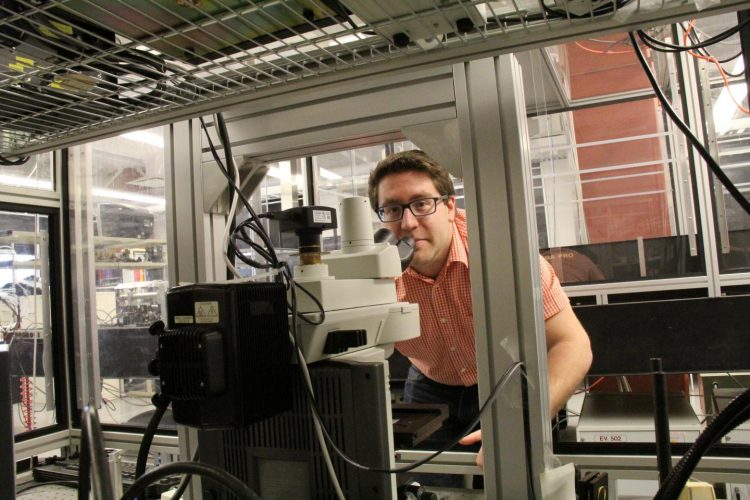Engineering researchers use laser to 'weld' neurons

UAlberta electrical engineering Ph.D. student Nir Katchinskiy led a research project that was able to "weld" neurons together using a femtosecond laser. Credit: UAlberta Engineering
A research team based in the University of Alberta Faculty of Engineering has developed a method of connecting neurons, using ultrashort laser pulses–a breakthrough technique that opens the door to new medical research and treatment opportunities.
The team is the first ever to find a way to bond neurons and in doing so, has given researchers a powerful new tool. Neurons are cells in the nervous system that are responsible for transferring information between the brain and the rest of the body.
“The immediate application is for researchers. They finally have a new tool to do what they have not been able to do before,” said Nir Katchinskiy, a second-year PhD student in Electrical Engineering who led the study. “We're engineers. We come up with tools that provide potential.”
The team's findings are published in the flagship scientific journal Nature Scientific Reports.
Katchinskiy had a real-life application in mind when he started the project.
“I was really interested in the nervous system–if you have a severed nerve, you can't repair it,” he said. “My thought was, what if we could 'weld' it back up right after it's injured?”
To conduct the study, two neurons, put in a special solution that prevents them from sticking together, were brought into contact with each other. Femtosecond laser pulses–each ultrashort pulse occurring every 10-15 seconds–were delivered to the meeting point of the two cells. Although the outside layer of the cells was partially compromised, the inside of that protective layer remained intact. As a result, the two cells established solid bonds forming a common membrane at the targeted area.
Throughout multiple experiments, the cells remained viable and the connection strong. It took the neurons 15 milliseconds to stick to each other–the process would have taken hours to occur naturally.
The biggest advantage of the discovery is that it gives researchers complete control on the cell connection process. “You can really plan any experiment. The idea is to show that you can use it (femtosecond laser) as a research tool to control what you are attaching,” said Katchinskiy.
“You may not be able to go in and treat the human spine with this, but it brings you closer,” said electrical engineering professor Abdul Elezzabi, who is a co-author of the paper and Katchinskiy's research supervisor. “But it brings you closer to how these things work.”
So far, the team has applied this method to three types of cells, but the potential of the technique seems limitless. For this project, Katchinskiy and Elezzabi, who are in the Department of Electrical and Computer Engineering, teamed up with professor Roseline Godbout from the U of A's Department of Oncology and Cross Cancer Institute and Dr. Helly Goez, a professor in the division of pediatric neurology in the Department of Pediatrics at the U of A Faculty of Medicine and Dentistry. Both are also co-authors of the paper.
“We have two of the biggest researchers on cancer working with us,” said Elezzabi, a professor who is Katchinskiy's research supervisor. Elezzabi says femtosecond lasers can prove efficient in prostate, brain and ocular cancer research and treatment. Another possible application is in post cancer surgery treatment.
Media Contact
All latest news from the category: Power and Electrical Engineering
This topic covers issues related to energy generation, conversion, transportation and consumption and how the industry is addressing the challenge of energy efficiency in general.
innovations-report provides in-depth and informative reports and articles on subjects ranging from wind energy, fuel cell technology, solar energy, geothermal energy, petroleum, gas, nuclear engineering, alternative energy and energy efficiency to fusion, hydrogen and superconductor technologies.
Newest articles

Properties of new materials for microchips
… can now be measured well. Reseachers of Delft University of Technology demonstrated measuring performance properties of ultrathin silicon membranes. Making ever smaller and more powerful chips requires new ultrathin…

Floating solar’s potential
… to support sustainable development by addressing climate, water, and energy goals holistically. A new study published this week in Nature Energy raises the potential for floating solar photovoltaics (FPV)…

Skyrmions move at record speeds
… a step towards the computing of the future. An international research team led by scientists from the CNRS1 has discovered that the magnetic nanobubbles2 known as skyrmions can be…





















